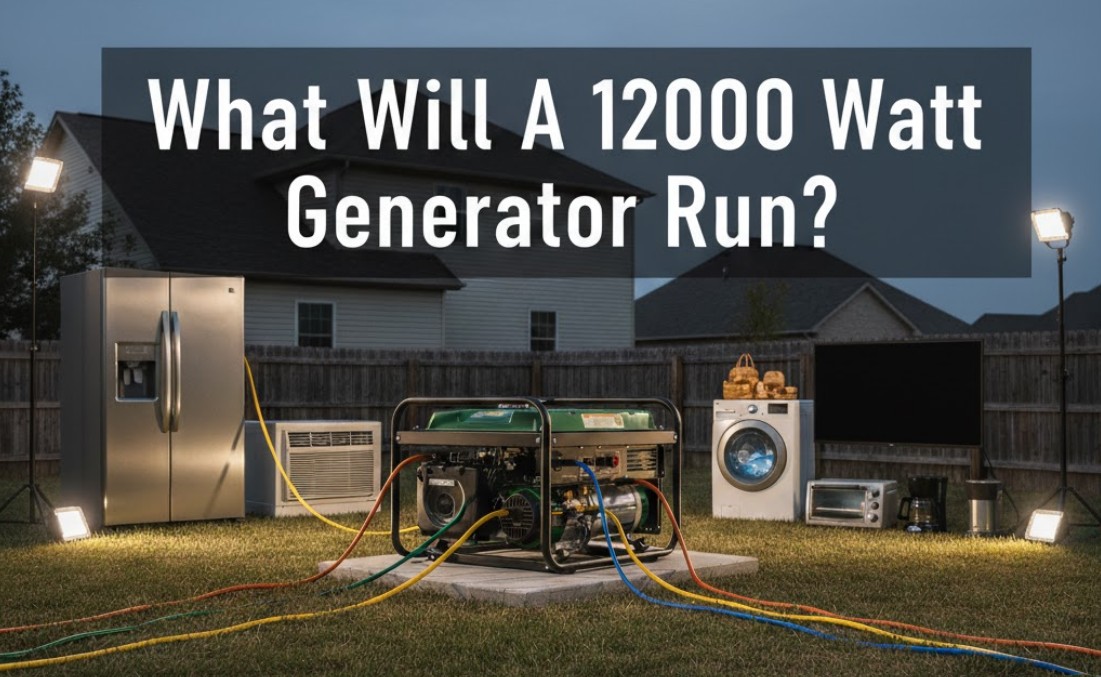When the power goes out, the difference between minor inconvenience and true disaster often comes down to one piece of equipment: the generator. Choosing the right size is the single most critical decision, and for many homeowners, a 12000-watt generator strikes the perfect balance between power, portability, and practicality. It’s a sweet spot in the backup power landscape, offering serious capacity without the permanent installation commitment of a large standby unit.

However, simply knowing the wattage isn’t enough. You need to understand how that power translates into the everyday function of your home. The question we aim to answer definitively is: What will a 12000 watt generator run? The short answer is: quite a lot! This comprehensive guide will break down the true capabilities of a generator in this power class, explaining the crucial difference between running watts and starting watts, and showing you exactly how to allocate 12,000 watts to keep your household comfortably running during an extended outage.
The Power Equation: Running Watts vs. Starting Watts
Before we can detail what a 12000 watt generator will run, we must clarify the two most important terms in generator sizing: running watts and starting watts (also called surge watts).
Running Watts (Rated Watts)
The running wattage is the continuous power the generator can produce reliably over a long period. When you see a generator advertised as 12,000 watts, this number almost always refers to the running wattage (or a close approximation thereof). This is the wattage you use to calculate the total continuous load of all the devices you plan to operate simultaneously.
Starting Watts (Surge Watts)
The starting wattage is the extra burst of power a generator can produce for a few seconds. This surge is necessary to start motor-driven appliances like air conditioners, refrigerators, freezers, well pumps, and air compressors. These inductive loads require significantly more power to spin up than they do to run continuously. For a generator rated at 12,000 running watts, the starting wattage often ranges between 15,000 and 18,000 watts.
The critical rule: When planning your usage, you must ensure that your total running watts (all devices operating) plus the starting watts of the largest single device that might turn on during that time do not exceed the generator’s starting wattage. This is the secret to successful generator management.
Transitioning smoothly between loads is also vital for generator longevity. To understand how to manage your loads effectively and prevent system shocks, you might find this information helpful: How do I prevent a sudden load increasing in a generator?
The 12,000-Watt Capability: Running a Modern Home
A 12000-watt generator is a powerhouse. It generally provides enough electrical capacity to run the essential systems of a medium to large-sized home, and in many cases, can run nearly the entire house with judicious load management. Below is a breakdown of what a 12000-watt generator will run, categorized by common household needs.
Essential Kitchen and Food Preservation
Food preservation is a top priority during an outage, and a 12,000-watt unit handles these loads easily:
- Refrigerator: (Running: 600-800W / Starting: 1,800-2,400W)
- Freezer (Large Chest): (Running: 500-700W / Starting: 1,500-2,000W)
- Microwave (1,000W): (Running: 1,000-1,500W)
- Electric Oven/Stove (One element): (Running: 1,500-2,500W – *Use sparingly*)
Even with a refrigerator and freezer cycling on their high starting loads, you still have well over 8,000 running watts remaining for other needs.
Climate Control and Comfort
The biggest power consumers in a home are often the HVAC systems. A 12000-watt generator can typically handle a significant portion of your climate needs, though careful planning is required due to high starting loads:
- Central Air Conditioning (3-ton unit): (Running: 3,500-5,000W / Starting: 10,000-15,000W). *This is the generator’s largest test. It can run a single 3-ton unit, but you must ensure nothing else starts simultaneously.*
- Window AC Unit (10,000 BTU): (Running: 1,200W / Starting: 2,500W)
- Furnace Fan (Gas or Oil, 1/2 HP): (Running: 800W / Starting: 1,500W)
- Space Heater (High setting): (Running: 1,500W)
Water, Communications, and Lighting
These are the core systems that maintain modern life and safety. A 12000-watt generator covers them without breaking a sweat:
- Well Pump (1 HP): (Running: 1,000-1,500W / Starting: 3,000-4,500W)
- Sump Pump: (Running: 800-1,200W / Starting: 2,000-3,500W)
- Home Security System & Router/Modem: (Running: 50-150W total)
- Lighting (LED/CFL): (Running: 500-1,000W total for key areas)
- Television and Cable Box: (Running: 200-500W)
Essentially, a 12000-watt generator can handle all of the above items *concurrently*, provided you stagger the starting of your major motor-driven appliances like the AC unit and the well pump.
Load Management: Running a Whole House (Nearly)
For those interested in maximum coverage, a 12000-watt generator can function as an excellent choice for best portable home backup generators, especially when coupled with a sub-panel and smart load management.
Scenario: Peak Load Allocation on 12,000 Running Watts
Let’s map out a typical emergency scenario to see how the wattage is distributed:
| Appliance/System | Running Watts | Starting Watts (If Motorized) |
|---|---|---|
| Central A/C (3-ton, running) | 4,500 W | N/A (already running) |
| Refrigerator & Freezer | 1,400 W | N/A (already running) |
| Well Pump (running) | 1,200 W | N/A (already running) |
| Furnace Fan/Blower | 800 W | N/A (already running) |
| General Lighting & Electronics | 1,000 W | – |
| Washing Machine (Hot cycle) | 1,500 W | – |
| Electric Water Heater (partial load) | 1,000 W | – |
| TOTAL RUNNING WATTS | 11,400 W | – |
In this high-demand scenario, the generator is running at 11,400 watts—very close to its maximum. However, this is only sustainable if no additional motor (like the well pump or A/C) tries to start simultaneously. If the 4,500W AC unit suddenly tried to start (requiring 12,000W or more), the system would immediately trip the breaker and shut down due to overload. Therefore, efficient use relies on sequencing or load shedding.
Comparing to Standby and Whole House Generators
A 12,000-watt portable unit provides significant backup, but it still requires manual oversight (fueling, starting, load management). If you want hands-free, seamless operation that powers all major appliances simultaneously without concern for starting loads, you might consider stepping up to a full best whole house generators, which often have higher surge capacities and run on natural gas or propane, eliminating the need for constant refueling. However, for cost-effective, high-capacity portable power, the 12000-watt generator is ideal, such as those found in the best 12000 watt generators category.
Tips for Maximizing a 12000 Watt Generator’s Efficiency
Owning a high-wattage generator requires a strategy to ensure you are getting the most from your investment, especially during long power outages.
Prioritize and Sequence Your Loads
Always turn on your highest starting watt appliances one at a time, beginning with the largest. For example, turn on the central A/C (which requires a massive surge), let it run and settle into its lower running wattage, and then start the well pump. Never rely on multiple high-surge appliances starting simultaneously.
Use the Right Fuel
Many 12000-watt generators are dual-fuel (gasoline and propane). Gasoline generally offers higher power output, which is crucial for maximizing your running and starting watts. Propane, however, can be stored longer and is often more readily available during widespread outages. Know your generator’s output rating for each fuel type.
Use a Generator Transfer Switch
To safely and legally connect your generator to your home’s electrical system, you must use a transfer switch or a dedicated power inlet box connected to a generator sub-panel. This system automatically or manually prevents dangerous backfeeding into the utility grid and simplifies the process of allocating power to your desired circuits.
Deep Dive: Considerations for Specific High-Wattage Appliances
A 12000-watt generator provides enough buffer to consider running appliances that smaller units simply cannot handle. However, running these requires vigilance.
Electric Clothes Dryer
A standard electric clothes dryer is typically rated at 4,000 to 5,500 running watts. You can run this appliance, but you must treat it as a temporary high load. When the dryer is running, you must temporarily shut off your air conditioning unit and possibly a secondary appliance like a space heater to stay safely below the 12,000-watt limit. Use this appliance for essential drying only.
Electric Water Heater
A large electric water heater can draw 4,500 to 5,500 watts when actively heating water. Instead of powering the entire water heater, many generator sub-panels are wired to only allow one of the heater’s two elements to run (around 2,250 watts), or the power is cycled manually. This reduces the load to a manageable level while ensuring you still have access to hot water, albeit slowly.
Power Quality for Sensitive Electronics
While a 12,000-watt generator has the raw power, not all conventional generators produce “clean power” (a true sine wave). For computers, smart TVs, and medical equipment, an inverter generator is usually preferred for its cleaner power output. While most 12,000-watt units are conventional, the power they produce is sufficient for all major motor-driven appliances. For highly sensitive electronics, consider adding an uninterruptible power supply (UPS) to buffer the input from the generator.
Final Thoughts
A 12000-watt generator offers robust, versatile power that can effectively back up nearly all essential systems in a typical modern home and often many of the comfort features as well. The definitive answer to what will a 12000 watt generator run is that it runs your life, comfortably and safely, provided you respect the crucial difference between running watts and starting watts. By strategically sequencing the startup of motor-driven appliances—such as your air conditioner, well pump, or furnace fan—you can prevent overloads and keep your household running smoothly on its 12,000 watts of continuous power. Investing in a generator of this size is a clear step towards peace of mind, offering significant capacity without the financial and logistical commitment of a fully permanent standby system.
Amranul is a highly experienced product review writer with a passion for helping readers make smart, informed purchasing decisions. Since 2018, he has specialized in thoroughly researching and analyzing a wide range of products to deliver honest, in-depth reviews. Amranul combines technical accuracy with clear, engaging writing to break down complex product features and highlight true user value. Look for his reviews to find reliable information and expert insights you can trust before you buy!





